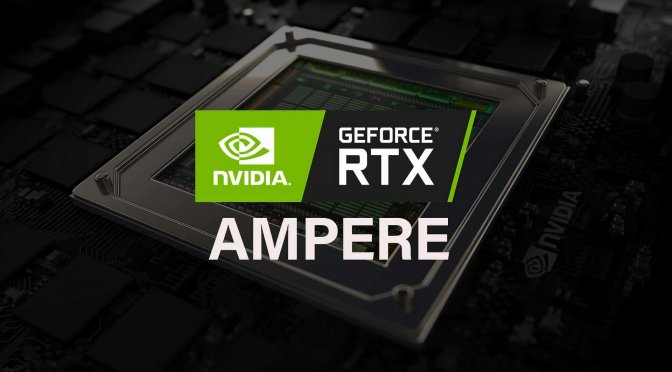Videocardz’s internal sources have just given us some update on the launch window of Nvidia’s yet to be announced Ampere-based RTX 3080 20 GB SKU.
According to Videocardz’s sources Nvidia plans to launch two more SKUs in the Ampere GPU lineup stack this coming December, the RTX 3080 20 GB and the RTX 3070 16 GB variants, respectively. It appears that there has been a slight change in Nvidia’s planned roadmap.
If you are looking to upgrade your GPU, then it would be wise to wait till December, since these upcoming refresh SKUs pack more VRAM frame buffer than their previous counterparts (that is of course if you can grab one at launch date).
An internal roadmap presentation slide from the GPU manufacturer GALAX already spilled the beans on some unreleased and upcoming GeForce RTX 30-series graphics cards last month. It was confirmed back then that NVIDIA is prepping three more SKUs in the Ampere lineup which would be the GeForce RTX 3080 20 GB, GeForce RTX 3070 SUPER/Ti, and the GeForce RTX 3060, respectively.
Some new product codenames for unreleased Nvidia GeForce RTX 30 series cards were also leaked before by Gigabyte as well. The company listed three variants, the GeForce RTX 3060 8 GB, RTX 3070 16 GB and the RTX 3080 20 GB, respectively. Though, according to Videocardz, there are no plans to release the RTX 3070 Ti or SUPER variant having 6144 CUDA cores anytime soon.
We can expect the Ti or Super SKUs to launch next year. The ‘PG142 SKU 0’-based board requires a full GPU die to be operational, and the current yields are also not satisfactory for the GA104-based GPU.
According to previous rumors, the RTX 3070 Super variant is expected to feature the PG142 board, and might come in 8 or 16 GB VRAM flavors, the non-X GDDR6 memory type. The RTX 3070 Ti on the other hand is expected to feature 16 GB of VRAM. We expect a 6144 CUDA core count for the RTX 3070 Ti/Super. The plain non-Super/Ti RTX 3070 card is having a total of 5888 CUDA cores, which is 256 cores less.
The RTX 3070 16 GB SKU carries the codename ‘PG142 SKU 05’. In the mainstream and mid-range segment we also have the RTX 3060 Ti SKU, and the launch date for this GPU has been pushed back to mid-November, according to Videocardz.
The company did not announce any plans to release this X60 SKU, the mainstream RTX 3060 card, though we have been hearing rumors that Nvidia might release two variants, based on the GA106 and GA104 GPU core/die.
The GA104 GPU would likely adopt the Ti or Super branding. We expect the GA106 GPU board to be featured on the plain RTX 3060 GPU (the non-Ti/Super variant), and rumor has it that this card might feature 6 GB of GDDR6 memory over a 192-bit wide bus interface.
The RTX 3060 Ti/Super on the other hand might feature 8 GB of GDDR6 memory over a 256-bit bus interface. According to @Kopite7kimi, who is a well known leaker, the RTX 3060 Ti/Super GPU would allegedly feature the GA104-200 GPU having a total of 4864 CUDA cores, in a total of 38 SMs, which is 1024 CUDA cores less than the RTX 3070’s 5888 count. The card is also said to feature only 8 GB of GDDR6 memory, since this is more of a successor to the GeForce RTX 2060 SUPER SKU.
The GeForce RTX 3080 20 GB model on the other hand is expected to feature the same CUDA core count as the 10 GB SKU at 8704 cores. But it makes little sense for Nvidia to just release a GPU having more VRAM, if the specs remain unchanged, so there are slight chances that Nvidia might release a higher-spec’d x80 series variant in the last moment, to counter AMD’s Big Navi GPU.
The RTX 3080 20 GB SKU would be based on the PG132 SKU20 board, and this card has been in the roadmap for quite some time.
Also, don’t expect similar pricing for these variants, since the GeForce RTX 3070 with 16 GB of VRAM could end up close to the pricing of the GeForce RTX 3080, and the RTX 3080 20 GB would cost roughly around $799-$899 USD.
These Ti/Super variants aren’t meant to replace the existing RTX 30-series lineup either, but they rather offer a step-up and upgrade in terms of memory and better core specs, but at higher prices. This all depends on how AMD responds back with their NAVI 2X lineup based on the new RDNA2 architecture.
Stay tuned for more!
Hello, my name is NICK Richardson. I’m an avid PC and tech fan since the good old days of RIVA TNT2, and 3DFX interactive “Voodoo” gaming cards. I love playing mostly First-person shooters, and I’m a die-hard fan of this FPS genre, since the good ‘old Doom and Wolfenstein days.
MUSIC has always been my passion/roots, but I started gaming “casually” when I was young on Nvidia’s GeForce3 series of cards. I’m by no means an avid or a hardcore gamer though, but I just love stuff related to the PC, Games, and technology in general. I’ve been involved with many indie Metal bands worldwide, and have helped them promote their albums in record labels. I’m a very broad-minded down to earth guy. MUSIC is my inner expression, and soul.
Contact: Email

